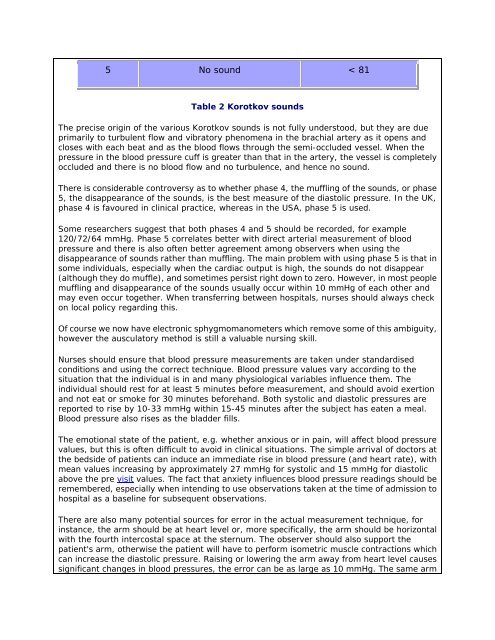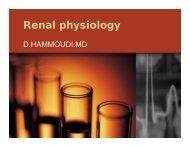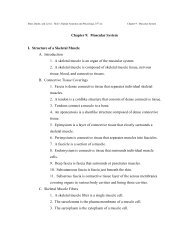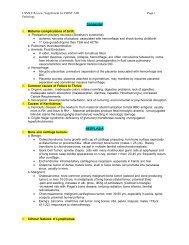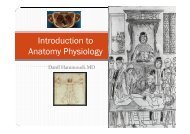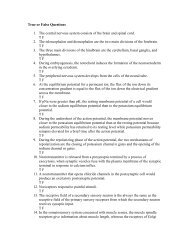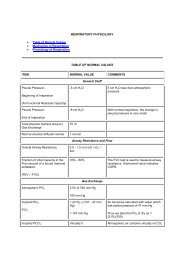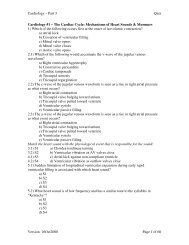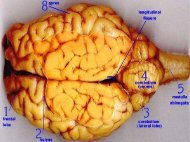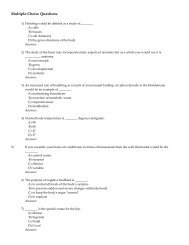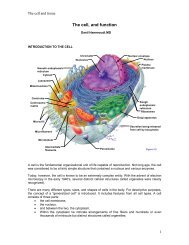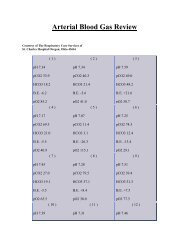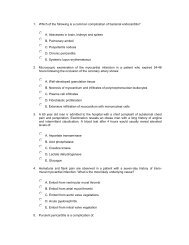Blood Vessels - Sinoe medical homepage.
Blood Vessels - Sinoe medical homepage.
Blood Vessels - Sinoe medical homepage.
You also want an ePaper? Increase the reach of your titles
YUMPU automatically turns print PDFs into web optimized ePapers that Google loves.
5 No sound < 81Table 2 Korotkov soundsThe precise origin of the various Korotkov sounds is not fully understood, but they are dueprimarily to turbulent flow and vibratory phenomena in the brachial artery as it opens andcloses with each beat and as the blood flows through the semi-occluded vessel. When thepressure in the blood pressure cuff is greater than that in the artery, the vessel is completelyoccluded and there is no blood flow and no turbulence, and hence no sound.There is considerable controversy as to whether phase 4, the muffling of the sounds, or phase5, the disappearance of the sounds, is the best measure of the diastolic pressure. In the UK,phase 4 is favoured in clinical practice, whereas in the USA, phase 5 is used.Some researchers suggest that both phases 4 and 5 should be recorded, for example120/72/64 mmHg. Phase 5 correlates better with direct arterial measurement of bloodpressure and there is also often better agreement among observers when using thedisappearance of sounds rather than muffling. The main problem with using phase 5 is that insome individuals, especially when the cardiac output is high, the sounds do not disappear(although they do muffle), and sometimes persist right down to zero. However, in most peoplemuffling and disappearance of the sounds usually occur within 10 mmHg of each other andmay even occur together. When transferring between hospitals, nurses should always checkon local policy regarding this.Of course we now have electronic sphygmomanometers which remove some of this ambiguity,however the ausculatory method is still a valuable nursing skill.Nurses should ensure that blood pressure measurements are taken under standardisedconditions and using the correct technique. <strong>Blood</strong> pressure values vary according to thesituation that the individual is in and many physiological variables influence them. Theindividual should rest for at least 5 minutes before measurement, and should avoid exertionand not eat or smoke for 30 minutes beforehand. Both systolic and diastolic pressures arereported to rise by 10-33 mmHg within 15-45 minutes after the subject has eaten a meal.<strong>Blood</strong> pressure also rises as the bladder fills.The emotional state of the patient, e.g. whether anxious or in pain, will affect blood pressurevalues, but this is often difficult to avoid in clinical situations. The simple arrival of doctors atthe bedside of patients can induce an immediate rise in blood pressure (and heart rate), withmean values increasing by approximately 27 mmHg for systolic and 15 mmHg for diastolicabove the pre visit values. The fact that anxiety influences blood pressure readings should beremembered, especially when intending to use observations taken at the time of admission tohospital as a baseline for subsequent observations.There are also many potential sources for error in the actual measurement technique, forinstance, the arm should be at heart level or, more specifically, the arm should be horizontalwith the fourth intercostal space at the sternum. The observer should also support thepatient's arm, otherwise the patient will have to perform isometric muscle contractions whichcan increase the diastolic pressure. Raising or lowering the arm away from heart level causessignificant changes in blood pressures, the error can be as large as 10 mmHg. The same arm


